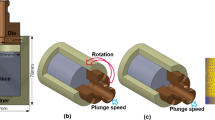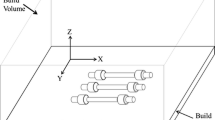Abstract
In this work, two simple models to calculate the strain rate at which material deforms during the friction stir welding (FSW) process are proposed. In both cases, predictions are associated with operational parameters such as rotational and travel speed and tool pin radius. A first model is based on the analysis of the strain experienced by the material on the periphery of the pin associated with the rotation and displacement present during the joining process. The second one is based on the resemblance of FSW with an asymmetric rolling process in which a dramatic strain gradient takes place. Using these models, and employing fitting parameters, it is possible to estimate the mean deformation rate during the FSW process. Very reasonable values, which fall in the range of strain rate data reported in the literature, are obtained. This new view should allow determining equivalent experimental conditions (strain, strain rate, and temperature in conventional uniaxial tests) under which this joining process occurs. This is critical to predict weld quality.










Similar content being viewed by others
References
Buffa G, Donati L, Fratini L, Tomesani L (2006) Solid state bonding in extrusion and FSW: process mechanics and analogies. J Mater Process Technol 177(1–3):344–347. https://doi.org/10.1016/j.jmatprotec.2006.04.042
Kumar K, Kailas SV (2008) The role of friction stir welding tool on material flow and weld formation. Mater Sci Eng A 485(1–2):367–374. https://doi.org/10.1016/j.msea.2007.08.013
Frigaard Ø, Grong Ø, Midling OT (2001) A process model for friction stir welding of age hardening aluminum alloys. Metall Mater Trans A 32(5):1189–1200. https://doi.org/10.1007/s11661-001-0128-4
Chang CI, Lee CJ, Huang JC (2004) Relationship between grain size and Zener–Holloman parameter during friction stir processing in AZ31 Mg alloys. Scr Mater 51(6):509–514. https://doi.org/10.1016/j.scriptamat.2004.05.043
Arora A, Zhang Z, De A, DebRoy T (2009) Strains and strain rates during friction stir welding. Scr Mater 61(9):863–866. https://doi.org/10.1016/j.scriptamat.2009.07.015
Dialami N, Cervera M, Chiumenti M (2018) Numerical modelling of microstructure evolution in friction stir welding (FSW). Metals (Basel) 8(3):183. https://doi.org/10.3390/met8030183
Zhao W, Wu CS (2019) Constitutive equation including acoustic stress work and plastic strain for modeling ultrasonic vibration assisted friction stir welding process. Int J Mach Tools Manuf 145(May):103434. https://doi.org/10.1016/j.ijmachtools.2019.103434
Kumar R, Pancholi V, Bharti RP (2018) Material flow visualization and determination of strain rate during friction stir welding. J Mater Process Technol 255:470–476. https://doi.org/10.1016/j.jmatprotec.2017.12.034
Gerlich A, Avramovic-Cingara G, North TH (2006) Stir zone microstructure and strain rate during Al 7075-T6 friction stir spot welding. Metall Mater Trans A Phys Metall Mater Sci 37(9):2773–2786. https://doi.org/10.1007/BF02586110
Ahmed MMZ, Wynne BP, Rainforth WM, Addison A, Martin JP, Threadgill PL (2019) Effect of Tool geometry and heat input on the hardness, grain structure, and crystallographic texture of thick-section friction stir-welded aluminium. Metall Mater Trans A Phys Metall Mater Sci 50(1):271–284. https://doi.org/10.1007/s11661-018-4996-2
Gerlich A, Su P, Yamamoto M, North TH (2007) Effect of welding parameters on the strain rate and microstructure of friction stir spot welded 2024 aluminum alloy. J Mater Sci 42:5589–5601. https://doi.org/10.1007/s10853-006-1103-7
Reynolds AP (2000) Visualisation of material flow in autogenous friction stir welds. Sci Technol Weld Join 5(2):120–124. https://doi.org/10.1179/136217100101538119
Srivatsan TS, Vasudevan S, Park L (2007) The tensile deformation and fracture behavior of friction stir welded aluminum alloy 2024. Mater Sci Eng A 466(1–2):235–245. https://doi.org/10.1016/j.msea.2007.02.100
Jacquin D, Guillemot G (2021) A review of microstructural changes occurring during FSW in aluminium alloys and their modelling. J Mater Process Technol 288(April 2020):116706. https://doi.org/10.1016/j.jmatprotec.2020.116706
Barbini A, Carstensen J, dos Santos JF (2018) Influence of a non-rotating shoulder on heat generation, microstructure and mechanical properties of dissimilar AA2024/AA7050 FSW joints. J Mater Sci Technol 34(1):119–127. https://doi.org/10.1016/j.jmst.2017.10.017
Zhou Z, Yue Y, Ji S, Li Z, Zhang L (2017) Effect of rotating speed on joint morphology and lap shear properties of stationary shoulder friction stir lap welded 6061-T6 aluminum alloy. Int J Adv Manuf Technol 88(5–8):2135–2141. https://doi.org/10.1007/s00170-016-8924-6
Milagre MX et al (2018) On the microstructure characterization of the AA2098-T351 alloy welded by FSW. Mater Charact 140(April):233–246. https://doi.org/10.1016/j.matchar.2018.04.015
Norena A E, Suarez P DA, Zuluaga P M, Hoyos P E, Montoya G Y (2019) Model-based proposal of a control strategy for friction stir welding. In: 2019 IEEE 4th Colomb. Conf. Autom. Control, pp 1–6. https://doi.org/10.1109/CCAC.2019.8920996
Hoyos E, López D, Alvarez H (2016) A phenomenologically based material flow model for friction stir welding. Mater Des 111. https://doi.org/10.1016/j.matdes.2016.09.009
Schneider J, Beshears R, Nunes AC (2006) Interfacial sticking and slipping in the friction stir welding process. Mater Sci Eng A 435–436:297–304. https://doi.org/10.1016/j.msea.2006.07.082
Selvaraj M (2013) A temperature dependent slip factor based thermal model for friction stir welding of stainless steel. Sadhana Acad Proc Eng Sci 38(6):1393–1405. https://doi.org/10.1007/s12046-013-0158-9
Bhimavarapu SB, Maheshwari AK, Bhargava D, Narayan SP (2011) Compressive deformation behavior of Al 2024 alloy using 2D and 4D processing maps. J Mater Sci 46(9):3191–3199. https://doi.org/10.1007/s10853-010-5203-z
Rajakumar S, Muralidharan C, Balasubramanian V (2011) Influence of friction stir welding process and tool parameters on strength properties of AA7075-T6 aluminium alloy joints. Mater Des 32(2):535–549. https://doi.org/10.1016/j.matdes.2010.08.025
Zhang H, Li L, Yuan D, Peng D (2007) Hot deformation behavior of the new Al-Mg-Si-Cu aluminum alloy during compression at elevated temperatures. Mater Charact 58(2):168–173. https://doi.org/10.1016/j.matchar.2006.04.012
Chen L, Zhao G, Yu J (2015) Hot deformation behavior and constitutive modeling of homogenized 6026 aluminum alloy. Mater Des 74:25–35. https://doi.org/10.1016/j.matdes.2015.02.024
Fernández R, Ibáñez J, Cioffi F, Verdera D, González-Doncel G (2017) Friction stir welding of 25%SiC/2124Al composite with optimal mechanical properties and minimal tool wear. Sci Technol Weld Join 22(6):526–535. https://doi.org/10.1080/13621718.2016.1268368
Tamano T, Yanagimoto S (1970) Theory of rolling for the range of mixed friction : Part 1, A new method of calculation for the rolling without tension. Bull JSME 13(63):1131–1138. https://doi.org/10.1299/jsme1958.13.1131
Author information
Authors and Affiliations
Corresponding author
Additional information
Publisher’s note
Springer Nature remains neutral with regard to jurisdictional claims in published maps and institutional affiliations.
Recommended for publication by Commission III - Resistance Welding, Solid State Welding, and Allied Joining Process
Rights and permissions
About this article
Cite this article
Hoyos, E., Montoya, Y., Fernández, R. et al. Approach to plastic deformation and strain rate in FSW process. Weld World 65, 1519–1530 (2021). https://doi.org/10.1007/s40194-021-01093-4
Received:
Accepted:
Published:
Issue Date:
DOI: https://doi.org/10.1007/s40194-021-01093-4




